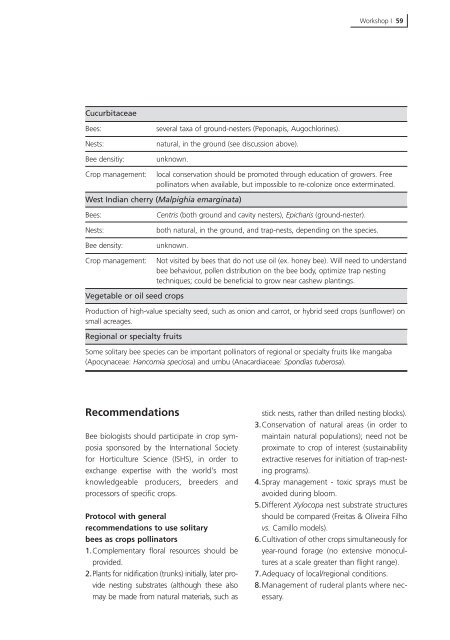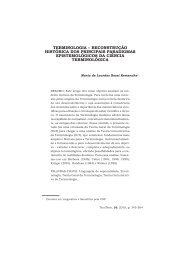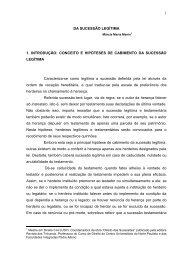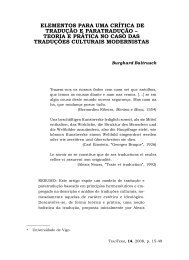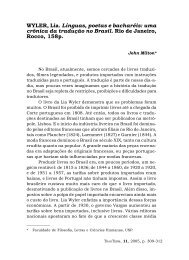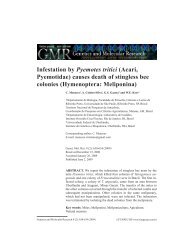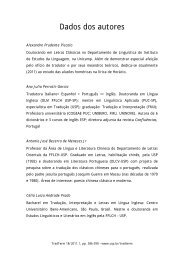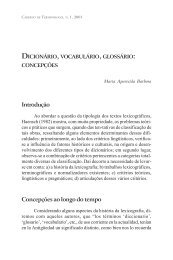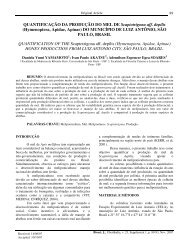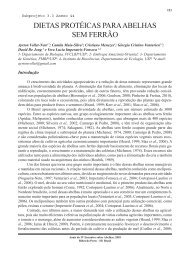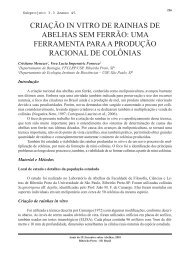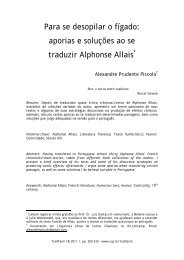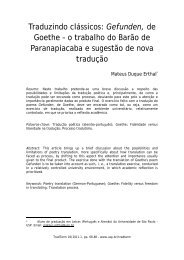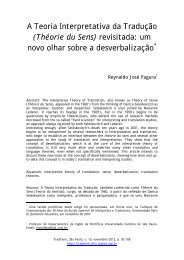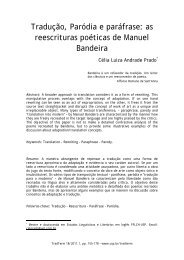Bees as pollinators in Brazil - USP
Bees as pollinators in Brazil - USP
Bees as pollinators in Brazil - USP
Create successful ePaper yourself
Turn your PDF publications into a flip-book with our unique Google optimized e-Paper software.
Cucurbitaceae<br />
<strong>Bees</strong>: several taxa of ground-nesters (Peponapis, Augochlor<strong>in</strong>es).<br />
Nests: natural, <strong>in</strong> the ground (see discussion above).<br />
Bee densitiy: unknown.<br />
Crop management: local conservation should be promoted through education of growers. Free<br />
<strong>poll<strong>in</strong>ators</strong> when available, but impossible to re-colonize once exterm<strong>in</strong>ated.<br />
West Indian cherry (Malpighia emarg<strong>in</strong>ata)<br />
<strong>Bees</strong>: Centris (both ground and cavity nesters), Epicharis (ground-nester).<br />
Nests: both natural, <strong>in</strong> the ground, and trap-nests, depend<strong>in</strong>g on the species.<br />
Bee density: unknown.<br />
Crop management: Not visited by bees that do not use oil (ex. honey bee). Will need to understand<br />
bee behaviour, pollen distribution on the bee body, optimize trap nest<strong>in</strong>g<br />
techniques; could be beneficial to grow near c<strong>as</strong>hew plant<strong>in</strong>gs.<br />
Vegetable or oil seed crops<br />
Production of high-value specialty seed, such <strong>as</strong> onion and carrot, or hybrid seed crops (sunflower) on<br />
small acreages.<br />
Regional or specialty fruits<br />
Workshop I 59<br />
Some solitary bee species can be important <strong>poll<strong>in</strong>ators</strong> of regional or specialty fruits like mangaba<br />
(Apocynaceae: Hancornia speciosa) and umbu (Anacardiaceae: Spondi<strong>as</strong> tuberosa).<br />
Recommendations<br />
Bee biologists should participate <strong>in</strong> crop symposia<br />
sponsored by the International Society<br />
for Horticulture Science (ISHS), <strong>in</strong> order to<br />
exchange expertise with the world's most<br />
knowledgeable producers, breeders and<br />
processors of specific crops.<br />
Protocol with general<br />
recommendations to use solitary<br />
bees <strong>as</strong> crops <strong>poll<strong>in</strong>ators</strong><br />
1.Complementary floral resources should be<br />
provided.<br />
2.Plants for nidification (trunks) <strong>in</strong>itially, later provide<br />
nest<strong>in</strong>g substrates (although these also<br />
may be made from natural materials, such <strong>as</strong><br />
stick nests, rather than drilled nest<strong>in</strong>g blocks).<br />
3.Conservation of natural are<strong>as</strong> (<strong>in</strong> order to<br />
ma<strong>in</strong>ta<strong>in</strong> natural populations); need not be<br />
proximate to crop of <strong>in</strong>terest (susta<strong>in</strong>ability<br />
extractive reserves for <strong>in</strong>itiation of trap-nest<strong>in</strong>g<br />
programs).<br />
4.Spray management - toxic sprays must be<br />
avoided dur<strong>in</strong>g bloom.<br />
5.Different Xylocopa nest substrate structures<br />
should be compared (Freit<strong>as</strong> & Oliveira Filho<br />
vs. Camillo models).<br />
6.Cultivation of other crops simultaneously for<br />
year-round forage (no extensive monocultures<br />
at a scale greater than flight range).<br />
7.Adequacy of local/regional conditions.<br />
8.Management of ruderal plants where necessary.


